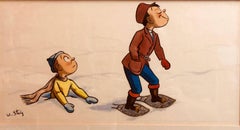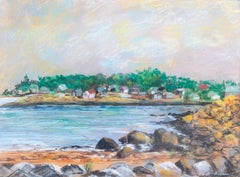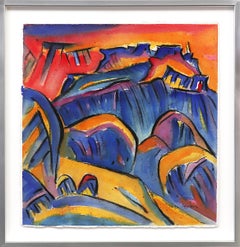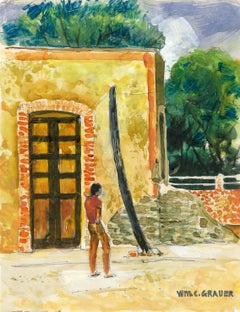American Modern Landscape Drawings and Watercolors
1930s American Modern Landscape Drawings and Watercolors
India Ink, Watercolor, Illustration Board
20th Century American Modern Landscape Drawings and Watercolors
Paper, Pastel
20th Century American Modern Landscape Drawings and Watercolors
Watercolor
1980s American Modern Landscape Drawings and Watercolors
Charcoal, Archival Ink, Watercolor
Late 20th Century American Modern Landscape Drawings and Watercolors
Watercolor
1960s American Modern Landscape Drawings and Watercolors
Watercolor
1930s American Modern Landscape Drawings and Watercolors
Paper, Pastel
1950s American Modern Landscape Drawings and Watercolors
Watercolor
1950s American Modern Landscape Drawings and Watercolors
Archival Paper, Oil Pastel
Late 20th Century American Modern Landscape Drawings and Watercolors
Pastel
1910s American Modern Landscape Drawings and Watercolors
Watercolor
1960s American Modern Landscape Drawings and Watercolors
Paper, Oil Pastel, Gouache
1960s American Modern Landscape Drawings and Watercolors
Paper, Ink, Watercolor
1930s American Modern Landscape Drawings and Watercolors
Paper, Pastel
1960s American Modern Landscape Drawings and Watercolors
Archival Paper, Watercolor
1930s American Modern Landscape Drawings and Watercolors
Gouache, Board
Late 20th Century American Modern Landscape Drawings and Watercolors
Watercolor
1930s American Modern Landscape Drawings and Watercolors
Paper, Pastel
Mid-20th Century American Modern Landscape Drawings and Watercolors
Watercolor
Mid-20th Century American Modern Landscape Drawings and Watercolors
Watercolor
Late 20th Century American Modern Landscape Drawings and Watercolors
Paper, Watercolor
1930s American Modern Landscape Drawings and Watercolors
Paper, Pastel
1980s American Modern Landscape Drawings and Watercolors
Watercolor, Laid Paper, Photographic Paper
1970s American Modern Landscape Drawings and Watercolors
Paper, Watercolor
Late 20th Century American Modern Landscape Drawings and Watercolors
Watercolor
21st Century and Contemporary American Modern Landscape Drawings and Watercolors
Chalk, Photographic Paper, Graphite
1990s American Modern Landscape Drawings and Watercolors
Watercolor, Ink, Charcoal
Early 20th Century American Modern Landscape Drawings and Watercolors
Carbon Pencil
1950s American Modern Landscape Drawings and Watercolors
Watercolor
Early 20th Century American Modern Landscape Drawings and Watercolors
Watercolor, Gouache
1940s American Modern Landscape Drawings and Watercolors
Gouache, Board
1980s American Modern Landscape Drawings and Watercolors
Watercolor, Paper
1980s American Modern Landscape Drawings and Watercolors
Watercolor
20th Century American Modern Landscape Drawings and Watercolors
Graphite
1930s American Modern Landscape Drawings and Watercolors
Paper, Pastel
1980s American Modern Landscape Drawings and Watercolors
Watercolor
Early 1900s American Modern Landscape Drawings and Watercolors
Paper, Watercolor
1920s American Modern Landscape Drawings and Watercolors
Watercolor
1940s American Modern Landscape Drawings and Watercolors
Paper, Watercolor
1980s American Modern Landscape Drawings and Watercolors
Ink
1980s American Modern Landscape Drawings and Watercolors
Watercolor
1930s American Modern Landscape Drawings and Watercolors
Gouache, Board
1970s American Modern Landscape Drawings and Watercolors
Photographic Paper, Color Pencil
1930s American Modern Landscape Drawings and Watercolors
Gouache, Board
1930s American Modern Landscape Drawings and Watercolors
Paper, Pastel
1940s American Modern Landscape Drawings and Watercolors
Watercolor, Board
1930s American Modern Landscape Drawings and Watercolors
Ink
1980s American Modern Landscape Drawings and Watercolors
Oil Pastel, Paper
1930s American Modern Landscape Drawings and Watercolors
Watercolor
1930s American Modern Landscape Drawings and Watercolors
Watercolor
1980s American Modern Landscape Drawings and Watercolors
Paper, Pastel
2010s American Modern Landscape Drawings and Watercolors
Mixed Media, Acrylic, Charcoal
1930s American Modern Landscape Drawings and Watercolors
Gouache, Board
Late 20th Century American Modern Landscape Drawings and Watercolors
Watercolor
1930s American Modern Landscape Drawings and Watercolors
Watercolor, Paper, Ink
1940s American Modern Landscape Drawings and Watercolors
Watercolor, Ink, Paper
2010s American Modern Landscape Drawings and Watercolors
Mixed Media, Acrylic
Early 2000s American Modern Landscape Drawings and Watercolors
Paint, Paper
1940s American Modern Landscape Drawings and Watercolors
Watercolor, Archival Paper
1950s American Modern Landscape Drawings and Watercolors
Paper, Watercolor




